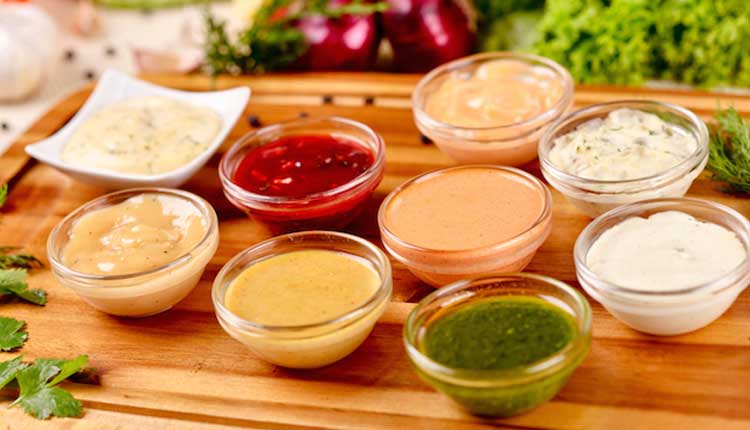Sauces are defined as liquids or semi-liquid mixtures which are flavored from stocks. They have a keen sense of taste, texture and require a strong hand of blending. The sauce is essentially a moist or liquid component which is served along with the dish in contrasting or complementary flavors.Grimande de la Royere, a great philosopher and gastronome wrote: “The sauce to culinary art is like what grammar is to language”. A perfect sauce has the colorful appearance, smooth, velvety texture, and a definite taste as well as a distinct flavor. It complements the food it accompanies.
Grimande de la Royere, a great philosopher and gastronome wrote: “The sauce to culinary art is like what grammar is to language”. A perfect sauce has the colorful appearance, smooth, velvety texture, and a definite taste as well as a distinct flavor. It complements the food it accompanies.
Sauces are classified on the basis of their application or the degree of heat at which they are prepared. The four key categories of sauces are:
- Hot Sauces
- Warm Sauces
- Cold Sauces
- Proprietary Sauces
- Contemporary Sauces
Hot Sauces
White or Béchamel Sauce: The sauce consists of milk thickened with a roux ( a mixture of equal quantity of butter and refined flour cooked together). Marquis Louis is said to have invented Bechamel sauce in the 17th century.
Brown or Espagnole
Espagnole meaning ‘Spanish’ in French was the original brown sauce and still is one of the glories of French Kitchen. Its name dates back to the 18th century. It is prepared by thickening brown stock with a brown roux (equal quantity of butter and flour cooked together up to brown color).
Veloute Sauce
It literally means ‘Velvet’. It is a light blond sauce made from the stock of chicken, fish or beef/veal thickened with a blonde roux (equal quantity of butter and flour cooked together up to blonde color).
Tomato Sauce
It is more commonly associated with Italian cuisine as an accompaniment to pasta dishes. It is prepared with pork, tomato concasse, tomato puree and thickened roux.
Warm Sauces
Hollandaise: It is a warm emulsified sauce prepared with egg yolk and clarified butter. Hollandaise is a French word meaning ‘Dutch style’. The sauce is named so because earlier a la hollandaise indicated a dish served with melted butter. It is thickened with emulsification of a warm sabayon of eggs yolk with melted clarified butter.
Cold Sauce
Mayonnaise: It is the only cold sauce among all the mother sauces. It is an emulsified sauce based on egg yolks. A lot of care needs to be taken while preparing mayonnaise. If it is not handled properly, the sauce may get separated and get a curdled appearance. It contains oil, egg yolk, and vinegar or lemon juice. It is always kept at chilled temperature. This sauce is always served cold and thus forms the base for most of the salads and sandwich fillings. It is generally served with the dipping sauce with snacks.
Proprietary Sauces
These sauces are made and used in the kitchens since a long time. For instance, Chinese Soya sauce was manufactured in the 16th century BC and is widely used today. Many of them are secret recipes passed from generation to generation. The list of proprietary sauces includes:
- Soya Sauce
- Worcestershire Sauce
- HP Sauce
- Ketchup
- Tabasco Sauce
- Chilli Sauce
Contemporary Sauces
Chefs today are responding to demands for lighter sauces or the sauces that are simpler, less rich and more easily prepared. Modern day sauces complement and enhances the flavor of the dish it accompanies, be it an egg preparation, a fish curry, a poultry based dish or vegetable based preparations. The examples of Contemporary Sauces include:
- Pesto Sauce (Italy)
- Salsa (Italy/ Mexico)
- Chimi churri (Argentina)
Points to remember while making a Sauce:
- Always use good quality stock to make sauces (For instance, chicken sauces should be prepared only by using chicken stock).
- The sauce should be smooth and glossy as per the purpose.
- Never allow a skin to be formed on top of a sauce as it may turn the sauce lumpy.
- To make the sauce glossy, pass it through a muslin cloth or a cheese cloth.
- Always season the sauce at the end, as a reduction of the sauce will result in the salty sauce.
- Never store the sauce beyond two days as the quality will deteriorate.
- Always cook the flour before adding to the sauce, else it will taste raw.
- Only use White Mirepoix for white sauce.
- Always use correct utensils to make sauces. Cooking white sauce in an aluminum container with steel whisk will turn the sauce grayish black.
- Check the seasoning in the cold sauce before serving.
As a direct outcome of the rise of globalized cuisines, the Chefs these days avoid very creamy and flour based sauces.


